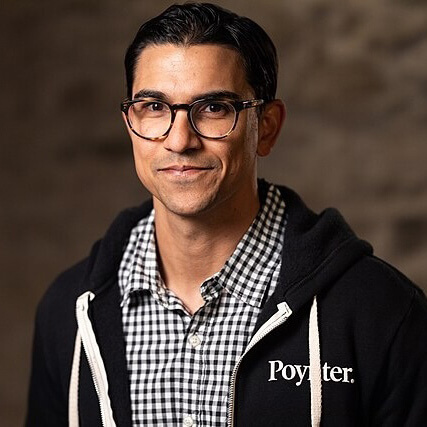Powell Tribune staff reporter CJ Baker thought a quote from a game warden in another news outlet seemed fishy. Turns out, it was probably generated by artificial intelligence.
Aaron Pelczar resigned from the Cody Enterprise this month after allegedly using generative AI — like ChatGPT — to make up quotes from a liquor store owner, an astronomer and a deputy district attorney, among others.
Baker began calling sources to verify quotes after reading an article about illegal elk hunting. The consensus from these calls: The quotes sounded innocuous and plausible — but they were never spoken. That’s a common characteristic of generative AI text.
Baker met with Pelczar and his editor in person with evidence about at least seven people who were quoted, but never interviewed. “It’s never comfortable to confront someone, but it’s especially uncomfortable when it involves colleagues (and competitors) in the media world,” Baker said. “What helped is that the editor at the Cody Enterprise, Chris Bacon, was gracious and receptive.”
In another oddity that’s characteristic of generative AI, the suspected stories added incorrect roles and educational titles to sources.
In one story, a professor of extragalactic astronomy was referred to as a meteorologist, and the “fireball report coordinator” for the American Meteor Society was given the title of doctor of astronomy.
And in one article, the author — likely AI — “‘took some liberties’ with what researchers know about raccoons’ cognition versus other species,” according to Baker’s reporting.
The Cody Enterprise, which was founded by William Frederick Cody, better known as Buffalo Bill, put out a statement that framed the incident as an “advanced form of plagiarism,” and said, “We now have a system set in place to catch AI generated stories. We will have longer conversations about how AI-generated stories are not acceptable, we will hold our employees to a higher standard and we stand by that.”
The outlet attached corrections to four articles, ranging from a story about a rare meteor shower to another about an embezzlement scandal.
“This sort of deception by a reporter is very similar to the old-fashioned ethical failures of plagiarism and fabrication. It’s what Jayson Blair did at The New York Times more than 20 years ago,” said Kelly McBride, Poynter’s senior vice president and the chair of the Craig Newmark Center for Ethics and Leadership. “He got caught when a reporter at a smaller paper called him out for plagiarizing her work.”
McBride said newsrooms can learn from this type of situation: There has to be close collaboration between reporters and editors. And that might include asking for a reporter’s notes if something seems off.
“Editors who brainstorm out with a reporter the purpose and the tone of a story ahead of time, as well as the reporting strategy, will have a lot of follow-up questions when some weird AI crap gets turned in,” she said.
The Cody Enterprise doesn’t have a public AI ethics policy. And this incident illustrates a weakness in many news organizations’ AI policies: They lack teeth. In this case, Pelczar resigned, and the paper issued its column and added corrections, but readers should always know what the consequences are for violating the trust of ethical AI use.
“It’s unfortunate, because we already know that the public thinks generative AI can be a form of journalistic cheating. And in this case, it was,” McBride said. “But there are going to be valid applications of AI in journalism. If the public doesn’t trust any of it, even when the application is good, they won’t believe the information.”
By Alex Mahadevan, MediaWise director
All eyes on Australia as the first contracts between Big Tech and publishers end
MELBOURNE — As the first contracts signed between platforms and publishers under Australia’s 2021 path-breaking news media bargaining code come to an end, talk has turned to what will replace them. On Wednesday, Prime Minister Anthony Albanese responded to a question about whether the government will impose a levy on social media companies.
“Social media companies have a social obligation,” he said. “… They should not be able to essentially harvest the work of news organizations that pay their journalists to do work, that should be valued.”
In 2021, Australia broke new ground by using competition law to get Google and Facebook to pay for news they use on their platforms. Political parties across the spectrum and publishers united around that common goal. Worried about the power imbalance between media outlets and the tech giants, Rod Sims, then the chair of the Australian Competition and Consumer Commission, proposed the code to push “digital platform companies” to negotiate with media outlets.
Under the code, if an agreement is not reached, the government can step in and require binding arbitration in which both sides submit a final offer.
Google and Meta paid out to dozens of outlets. Sims said the amount was $250 million AUD a year. As those contracts end, Google said it will not renew for more than one year at a time. Meta has said it will exit disseminating news in Australia, and has also threatened to exit South Africa if a code-type law is passed there. When Meta dropped news in Canada, traffic for small publishers plummeted.
The code has been widely viewed as a success in Australia, so government committees are considering a number of options. They include mandating “must carry” provisions so that platforms can’t drop news if they are told to pay for it, requiring (or “designating”) Meta and other platforms (such as Tiktok) to pay under the code, and imposing some sort of tax and local content requirement on Spotify and Netflix. There’s also discussion of whether the bargaining code can be expanded to include generative artificial intelligence firms, but now that News Corp. has signed a deal with OpenAI, the Rupert Murdoch firm is no longer lobbying for regulation.
Another idea that keeps coming up is a levy on social media, possibly dedicated to supporting quality journalism. Given the widespread lack of public enthusiasm for tech companies, there could be a lot of support for the idea.
“Technically, it’s not difficult to do and politically it’s amazing. These companies are as popular as a snake in a sleeping bag,” one Australian treasury official said to me this week.
One problem some officials see with this option is that Google and Meta have been offshoring their profits for years (including 1 billion AUS last year), and so are unlikely to pay. And were the Australian government able to collect, it’s not clear that funds would be given to journalism rather than put back in the general pot.
The world is watching Australia to see what it does next. A group of Indonesian editors are visiting this week to learn how to implement their country’s version of the code. Malaysia is also considering applying Australia’s model.
By Anya Schiffrin, contributor
Are we seeing more women’s sports?

LSU forward Angel Reese (10) battles for a rebound against Iowa forward Hannah Stuelke (45) and guard Caitlin Clark (22) during the second half of an Elite Eight round college basketball game during the NCAA Tournament, Monday, April 1, 2024, in Albany, N.Y. (AP Photo/Hans Pennink)
Even before the remarkable victories we’ve seen from America’s women athletes at the Paris Olympics, you might have seen a little more coverage of women’s sports in mainstream media. (Think Caitlin Clark and Angel Reese.)
A content analysis of coverage during the Tokyo Olympics found “three major U.S. dailies ran more stories about women’s than men’s sports, confirming the trend recorded in networked television prime-time programming toward a finally adequate representation of female athletes.”
That study, by Jenny Dean at Texas Wesleyan University and Francesco Somaini at Central Washington University, looked at coverage from The Dallas Morning News, The Star Tribune and The Seattle Times during two weeks of the games.
Here’s part of the study’s conclusion (minus the scholarly links to all their sources: “The main finding of this study is that not only did the news coverage of the 2021 Tokyo Olympics by the three U.S. dailies analyzed reflect the substantial equality of gender representation among athletes performing at the Olympic Games that is projected to be fully achieved by the 2024 Games scheduled in Paris; the American dailies in question actually offered greater coverage of women’s sports than they did of men’s. In other words, they provided evidence that a finally adequate representation of women athletes is not confined to the prime-time programming of networked television, but extends to the realm of newspaper coverage. While a trend approaching equality of treatment in the U.S. media has been highlighted by studies conducted over the past four decades, that trend has been recorded mostly in television programming about the Olympic Games; the fact that the coverage of women’s sports surpassed that of men’s in local newspapers too provides important additional evidence of a refreshingly positive development in media representations of women athletes.”
Check out the full study, its limitations and the authors’ other conclusions here.
By Kristen Hare, faculty
CNN media reporter Oliver Darcy goes indy
Oliver Darcy, senior media reporter at CNN (and a frequent source for us to compare notes to as we draft this newsletter), has left the network and gone independent. A new nightly newsletter called Status appeared in his subscribers’ inboxes this morning.
Status bills itself as the “reliable source for media news,” hearkening back to the canceled CNN Sunday show that focused on media and associated newsletter, which Darcy has run in recent years. It promises hard-hitting reporting, uncompromising analysis and no false equivalences.
Subscriptions to the newsletter start at $15 a month, or $150 per year.
“Oliver has established himself as a tough but scrupulously fair leading voice in media reporting and commentary — never afraid to call it as he sees it,” said CNN CEO Mark Thompson told Variety in a statement. “He has been a great shepherd of CNN’s Reliable Sources newsletter, and we wish him every success in his new entrepreneurial adventure.”
Darcy joined CNN in 2017 and took over the Reliable Sources newsletter when founder Brian Stelter departed the network in 2022, during CEO Chris Licht’s tumultuous reign. A CNN spokesperson told TheWrap that Reliable Sources will take a summer hiatus and return in the fall with a new lead writer.
“To say that it has been a hell of a ride at CNN would be an understatement,” Darcy wrote in his final edition of the CNN newsletter. “It has been the privilege of my career to serve as the steward of Reliable Sources, particularly at a time in which truth is under assault and people are thirsty for honest, trustworthy information. After all, the media is at the epicenter of truth.”
Ren LaForme, managing editor
David Gonzalez leaves The New York Times
I have a favorite photo from New York Times visual journalist David Gonzalez, and I’m certain other fans of his work can guess which one. It’s a black-and-white image made in 1979, at a street fair in the Mott Haven neighborhood of The Bronx. A suited man is pictured with a woman in heels. They’re dancing salsa in a close embrace. The man’s hand clutches her purse against the small of her back. The photo is mesmerizing, partly because the person who shot it is a journalist I admire, who for decades has documented the city’s Latino communities with authenticity.
After nearly 34 years, Gonzalez is leaving the Times. I found out the news through Facebook, where the proud Nuyorican and South Bronx native shared the official announcement from Times managing editor Marc Lacey and deputy managing editor Monica Drake. “It is with mixed emotions that we are writing to let you know that a New York Times stalwart, David Gonzalez, has decided to leave to pursue independent writing and visual projects,” the announcement read.
It feels surreal. As a journalist who, like Gonzalez, was born in New York City (shout out to Brooklyn!), I have long admired him for dedicating his career to stories about New York, Latinos, the Bronx and more. I’ve appreciated his documentation of and reflections on his beloved Bronx, of his richly told stories about a Pentecostal storefront church in Harlem, of his photos through the years of dance as an expression for Puerto Rican New Yorkers. The city has changed so much since I last lived there, but I always felt that at least it had Gonzalez capturing its spirit. He has held many positions at the Times over the years: Bronx bureau chief, Metro religion writer, columnist, co-editor for Lens, the Times’ photojournalism blog.
“I’m very proud of what I’ve contributed there. I put my record up against anybody’s,” Gonzalez told me over the phone Thursday. “I always said years ago that if you wanted to look at my work in the Bronx, not one story is going to do it. It has to be over time.”
Gonzalez said he feels good leaving now. He’s spent about half his life at The New York Times. Since the announcement, the journalist has been flooded with well-wishes from family, friends and readers. “What was really, really satisfying was that people got it. They said I did it my way, and I did it with integrity and honesty,” he said. “And those are the things that are non-negotiable for me as a journalist.”
Gonzalez has many projects before him. He has a vast archive he needs to organize, and he’s preparing for a few exhibits featuring his work on Latin American religion and Nuyoricans. He also has to finish a proposal for a collection of essays. “I’m not going to do anything different,” he said. “If anything, I’m just going to do things on my terms.”
I look forward to seeing what’s next.
By Amaris Castillo, contributor
Media tidbits and links for your weekend review
- The ABC News debate between former President Donald Trump and Vice President Kamala Harris set for Sept. 10 is back on — for now.
- Journalists at Hearst Connecticut Media Group — which includes 10 dailies, 13 weeklies, a statewide magazine and a website — announced Thursday that they are unionizing with the NewsGuild. If successful, the union will have 110 members. More than 84% of eligible staff have signed union authorization cards.
- Rioters have targeted mosques and Muslim communities in the United Kingdom after social media users misidentified a man who killed three children with a knife. The BBC’s Marianna Spring dug into Channel3Now, “a website whose story giving a false name for the 17-year-old charged over the Southport attack was widely quoted in viral posts on X,” and wrote, “The real story of the news website accused of fuelling riots.”
- Guardian US reporter Sam Levine points out a valuable interview lesson in this New Yorker article about Nancy Pelosi. David Remnick got a remarkable quote from Pelosi just by sitting silently.
- CNN international correspondent Larry Madowo was reporting live from Nairobi, Kenya, on Thursday when he was hit by fragments from projectiles fired at him by police. Watch the dramatic video here.
- Who’s to blame for pink slime news sites? Columbia Journalism Review’s Priyanjana Bengani tracked down some of the funders of these partisan sides masquerading as news in “The Non-Profits and PACs that spent $14 million on the Metric Media network in 2021-22.”
- Kamala Harris has yet to take questions from reporters since launching her campaign nearly three weeks ago. The Daily Beast’s Mary Ann Akers and Mini Racker with “Trump Turns Up Heat on Harris Over Dodging the Press.” But, Politico Playbook notes, Harris has been chatty with political reporters off the record, very unlike President Joe Biden.
- Talking Points Memo’s David Kurtz with “20 Years Later, Political Press Still Falls Hard For Swift Boat Attacks.”
- CNN is bolstering its late-night, weekend comedy offerings by bringing on former “Daily Show” correspondent Roy Wood Jr. to host “Have I Got News For You,” an adaptation of a long-running BBC panel comedy show. Variety’s Brian Steinberg has more.
- Finally, something really fun. The first trailer for “Saturday Night” dropped Thursday. “Saturday Night” is a Jason Reitman-helmed film about the first episode of “Saturday Night Live.” The casting looks immaculate and the whole thing seems like a massive, delightful mess.
Today’s Poynter Report was written by Alex Mahadevan, Anya Schiffrin, Kristen Hare, Amaris Castillo, Angela Fu and Ren LaForme.
More resources for journalists
- Get an AI ethics framework for your newsroom. Start here.
- Public media journalists: attend our Digital Transformation Project Q&A webinar Aug. 13.
- Work-Life Chemistry: Ditch work-life balance for a more sustainable approach.
Have feedback or a tip? Email Poynter senior media writer Tom Jones at tjones@poynter.org.
The Poynter Report is our daily media newsletter. To have it delivered to your inbox Monday-Friday, sign up here.











